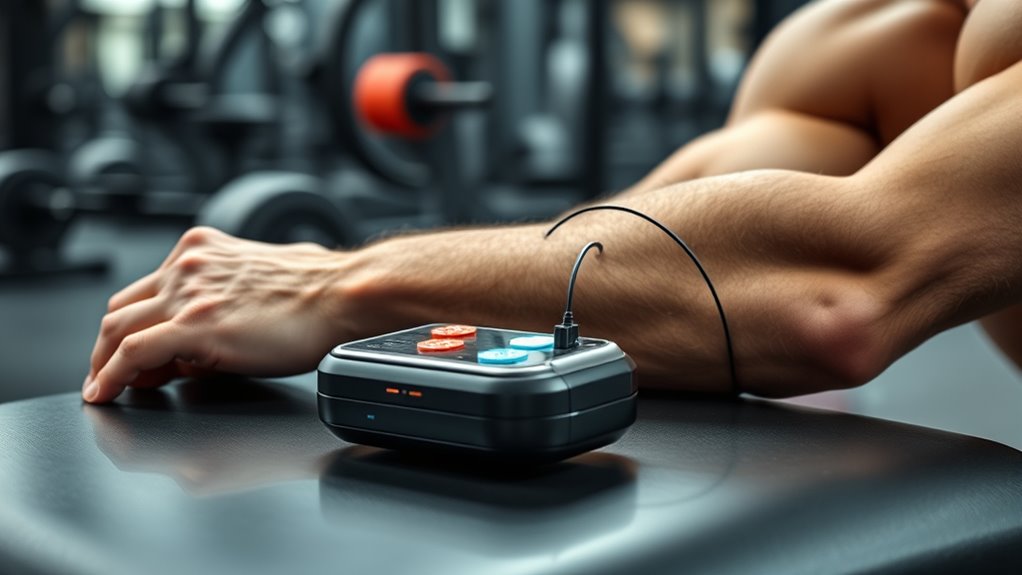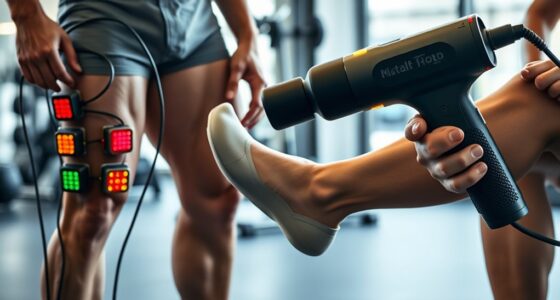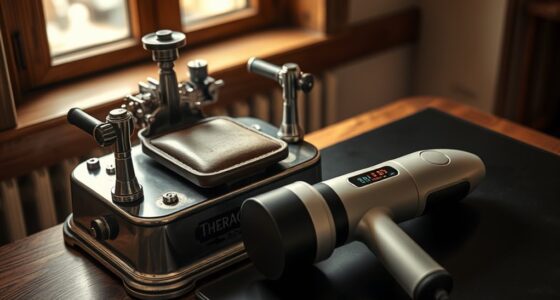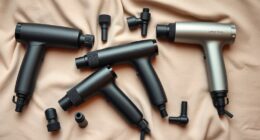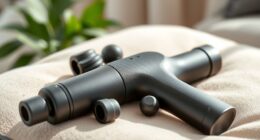Muscle stimulators work by sending electrical impulses that mimic brain signals, causing muscles to contract involuntarily. They can aid recovery by improving blood flow and reducing fatigue, but scientific evidence shows mixed results, often comparable to placebo. While they support muscle activation, they shouldn’t replace rest or proper nutrition. Whether they’re worth it depends on your goals and proper usage. Keep exploring to find out how you can get the most from these devices.
Key Takeaways
- Scientific evidence shows mixed results; some studies suggest modest recovery benefits, but many findings are not significantly better than placebo.
- Proper electrode placement and device use are crucial for effectiveness; incorrect usage reduces potential recovery benefits.
- Muscle stimulators can aid recovery by increasing blood flow and reducing fatigue, but they do not replace rest or traditional methods.
- High device costs and limited conclusive evidence raise questions about their cost-effectiveness compared to conventional recovery techniques.
- They may be useful as a supplement for specific goals like soreness reduction, but are not essential for effective muscle recovery.
How Do Muscle Stimulators Work?
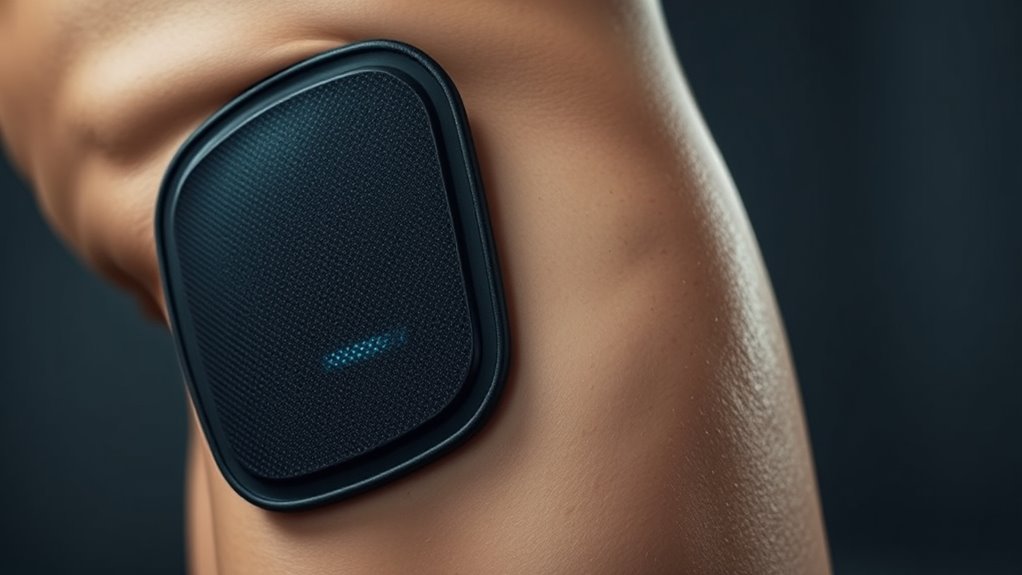
Muscle stimulators work by sending electrical impulses directly to your muscles, mimicking the signals your brain sends during voluntary contractions. To do this effectively, proper electrode placement is vital—you want the pads positioned over the targeted muscle groups to guarantee ideal stimulation. Once in place, the device delivers controlled pulses that cause your muscles to contract involuntarily. Battery life plays a key role in usability; longer-lasting batteries mean you can enjoy extended sessions without interruption. Many devices have rechargeable batteries, so you don’t have to worry about frequent replacements. Keep in mind that maintaining correct electrode placement and monitoring battery life will help you get the most out of your muscle stimulator, making your recovery or training sessions more efficient. Additionally, understanding the mechanism of action can help optimize the benefits of electrical stimulation.
Scientific Evidence Supporting or Questioning Their Effectiveness
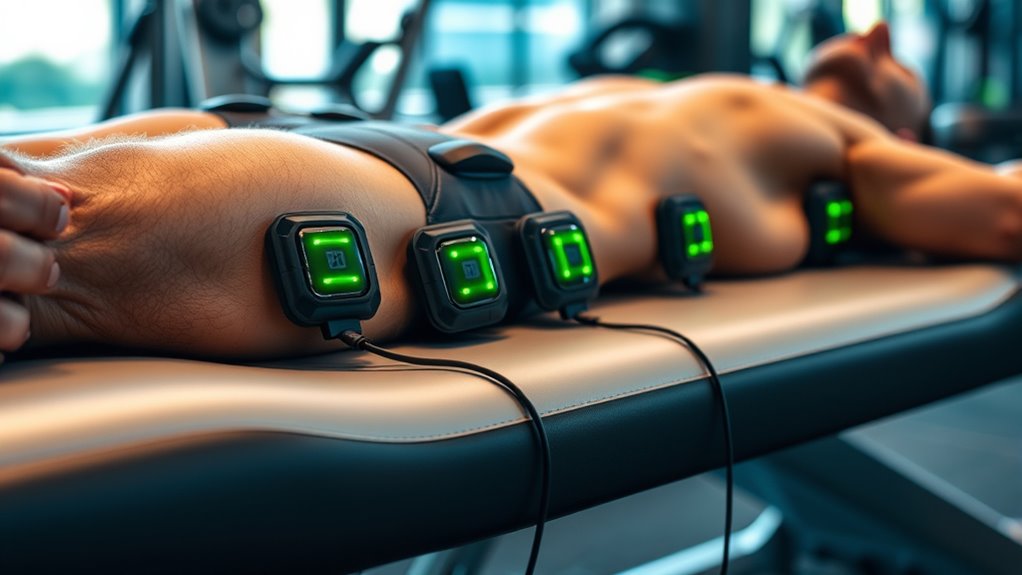
While some studies highlight the potential benefits of muscle stimulators for improving muscle strength and recovery, scientific evidence remains mixed. Many positive results could be influenced by the placebo effect, where users experience perceived improvements simply because they believe in the device’s effectiveness. Some research shows modest gains, but these often aren’t markedly better than placebo treatments. Additionally, questions about cost effectiveness arise, especially when considering the high price of these devices compared to traditional recovery methods. If the benefits are mainly psychological or marginal, you might be wasting money on equipment that offers limited real value. Overall, current scientific evidence doesn’t conclusively support muscle stimulators as essential recovery tools, making it important to weigh their actual benefits against their costs. Facilitate collaboration among users and researchers could help clarify their true effectiveness.
Benefits and Limitations for Muscle Recovery
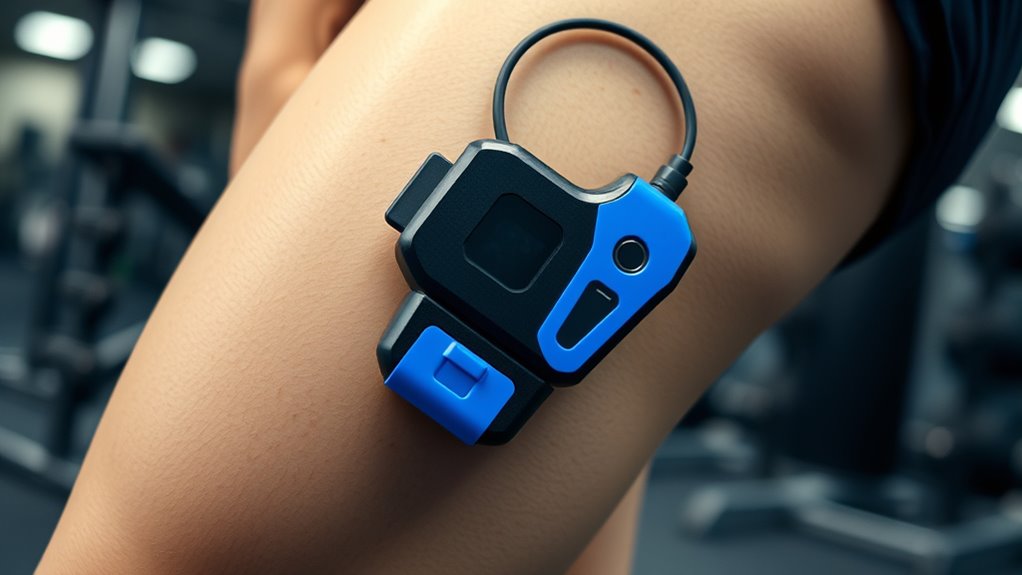
Are muscle stimulators effective tools for enhancing recovery? They can help reduce muscle fatigue by promoting better blood flow and muscle activation after workouts. This may lead to quicker removal of waste products and faster repair of microscopic muscle damage. Additionally, using stimulators can support injury prevention by maintaining muscle tone and preventing imbalances that could cause strains or other injuries. However, their benefits are limited; they don’t replace proper rest, nutrition, or active recovery methods. Overreliance might lead you to overlook these essentials. Plus, muscle stimulators aren’t a one-size-fits-all solution. Their effectiveness varies based on individual needs, workout intensity, and proper usage. While they offer some recovery advantages, they shouldn’t be viewed as a magic fix for muscle fatigue or injury prevention. Furthermore, understanding Mazda Tuning can help you optimize recovery routines by integrating appropriate vehicle maintenance strategies to avoid overtraining or injury.
Practical Considerations Before Buying a Muscle Stimulator
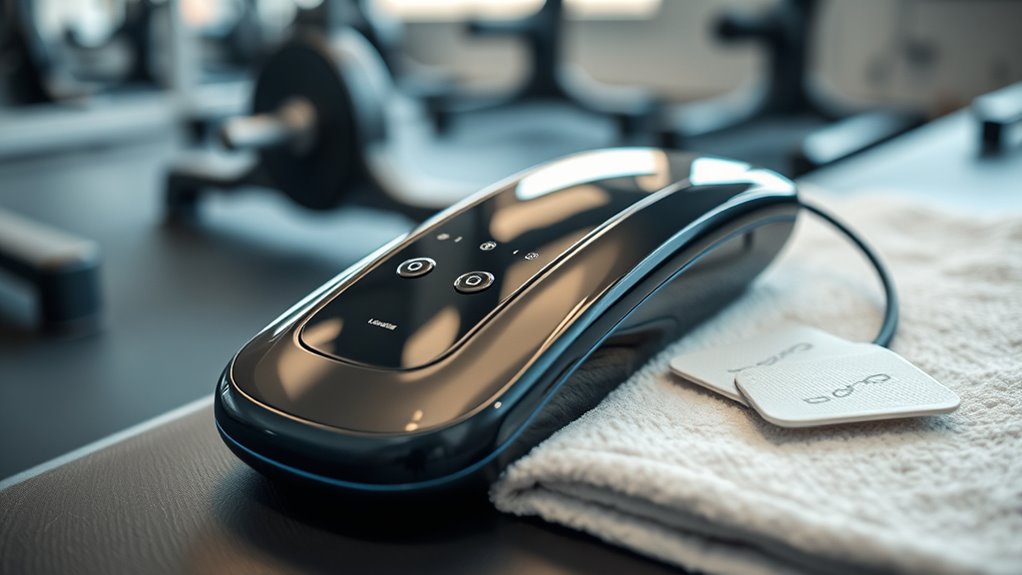
Before purchasing a muscle stimulator, it’s important to contemplate your specific recovery needs and fitness goals. Consider whether the device offers good cost effectiveness—will it provide long-term value without draining your wallet? Research user experiences to gauge real-world effectiveness and ease of use. Reading reviews helps identify models that are reliable and suited to your needs, saving you time and money. Be mindful of features that matter most to you, such as adjustable intensity levels or portability. Also, check if the device has proper safety certifications. By weighing these factors, you ensure that your investment aligns with your recovery strategy and offers genuine benefit, rather than becoming an unnecessary expense. Additionally, understanding the maintenance and troubleshooting aspects can help prolong the device’s lifespan and ensure consistent performance.
Determining if a Muscle Stimulator Fits Your Fitness Goals
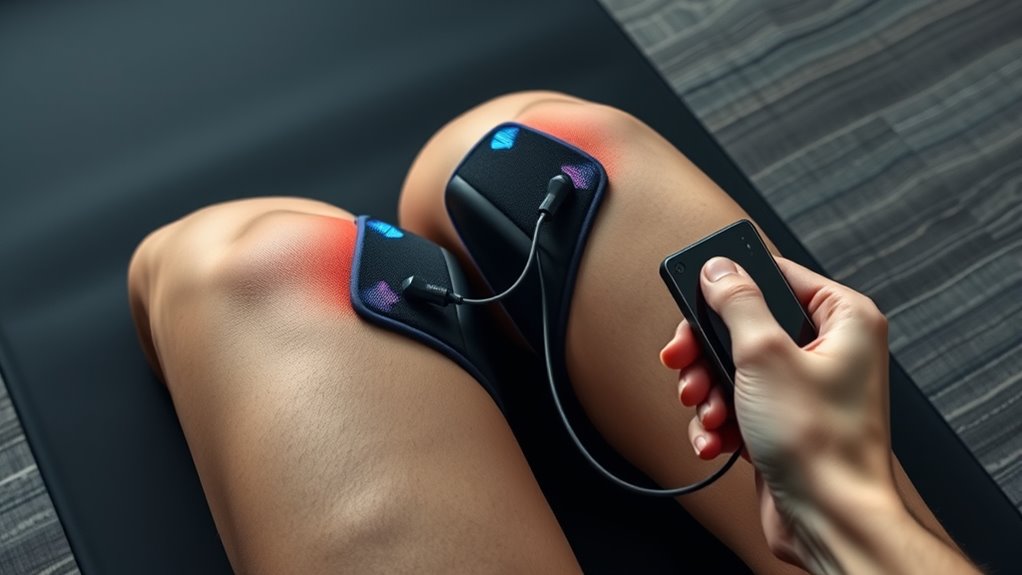
To determine if a muscle stimulator aligns with your fitness goals, start by clarifying what you want to achieve—whether it’s muscle recovery, strength building, or endurance enhancement. If your focus is on reducing muscle fatigue after workouts, a stimulator can help by promoting blood flow and speeding up recovery. For pain reduction, look for devices designed to target soreness and discomfort effectively. However, if your goal is outright strength or endurance gains, a stimulator alone may not be sufficient; it should supplement a thorough training plan. Consider how the device addresses your specific needs, and verify it’s versatile enough to support your desired outcomes. Matching the stimulator’s capabilities with your goals helps you make an informed decision and maximize your results. Additionally, understanding the types of muscle stimulators available can help you select the most suitable device for your needs.
Frequently Asked Questions
Are Muscle Stimulators Suitable for All Fitness Levels?
You might wonder if muscle stimulators suit your fitness level. They’re generally suitable for beginners, helping with muscle activation and recovery, but advanced trainers can also benefit from targeted use to enhance performance. However, it’s important to start with low intensity and proper guidance to avoid injury. Whether you’re just starting out or pushing your limits, muscle stimulators can complement your routine if used correctly and thoughtfully.
How Long Should I Use a Muscle Stimulator per Session?
For each session, you should typically use a muscle stimulator for about 15 to 30 minutes. Focus on proper electrode placement to target the right muscle groups effectively. Avoid overusing it, as longer sessions won’t necessarily improve results and could cause discomfort. Stick to the recommended session duration, and always follow the device instructions to guarantee safety and maximize benefits.
Can Muscle Stimulators Replace Traditional Strength Training?
Think of muscle stimulators as a quick spark rather than a full blaze. They can’t replace traditional strength training because electrode placement targets specific muscles temporarily, while real muscle adaptation requires consistent effort. You need the resistance and variety of exercises to build strength, not just stimulation. So, while stimulators can supplement your routine, they shouldn’t be relied on as the main method for muscle growth.
Are There Any Side Effects or Risks Associated With Use?
You might wonder about muscle stimulator safety and potential side effects. While generally safe when used properly, overuse or incorrect settings can cause skin irritation, discomfort, or muscle fatigue. Rarely, some users experience burns or nerve damage. To minimize risks, follow manufacturer instructions carefully, avoid prolonged sessions, and consult a healthcare professional if you have underlying health conditions. Staying informed helps guarantee safe, effective use.
What Is the Typical Cost Range for Quality Muscle Stimulators?
You might think quality muscle stimulators are pricey, but the price range varies widely depending on features and brand. Expect to spend anywhere from $30 to over $200 for a reliable device, with higher prices often reflecting better product quality and durability. While budget options exist, investing in a reputable stimulator guarantees better effectiveness and safety, making the cost worthwhile for serious recovery or training needs.
Conclusion
Ultimately, muscle stimulators can be helpful if you view them as a supplement, not a miracle. While they might boost recovery and ease soreness, they won’t replace hard work or proper training. Don’t fall for the hype—question the science and listen to your body. Think of them as a tool in your fitness kit, but trust that real progress comes from consistent effort. Stay informed, stay motivated, and make smart choices for your goals.
